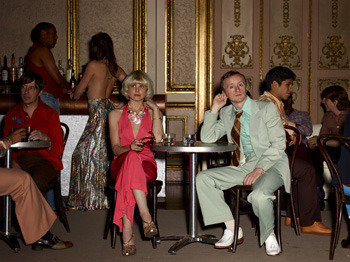Stan Douglas
dal 21/3/2012 al 27/4/2012
Segnalato da
21/3/2012
Stan Douglas
David Zwirner, New York
For this exhibition, titled Disco Angola, Douglas has assumed the fictional character of a photo-journalist in the burgeoning disco underground of the early 1970s New York.

David Zwirner is pleased to present an exhibition of new work by Stan Douglas, on view at 525 West 19th Street. Since he joined the gallery in 1993, Douglas has had ten solo exhibitions, including Midcentury Studio last year, which debuted a project created in the guise of a mid-twentieth century press photographer.
For this exhibition, titled Disco Angola, Douglas has again assumed the fictional character of a photo-journalist, this time a regular in the burgeoning disco underground of the early 1970s New York. For Douglas’s alter-ego, the new scene offered a cathartic respite from urban grittiness in a city on the verge of bankruptcy. Evolving out of funk and soul, the disco lifestyle mobilized the gay community in particular, and its self-conscious embrace of glamour and fashion represented a departure from the previous decade’s counterculture.
Cameroonian saxophonist Manu Dibango is widely credited for writing the first disco hit, the song “Soul Makossa” from 1972, and the movement as a whole took much of its inspiration from the African continent. Douglas’s photographer traveled frequently to Angola, where civil war broke out in 1974 following a bloodless coup d’état to end Portuguese rule. His photographs reveal subtle parallels between the burgeoning disco culture and the Angolan liberation struggles.
The exhibition presents eight works from the project: four based in Angola, and four in the photographer’s native New York. Researching archival photographs, period costumes, and decor, Douglas has meticulously recreated “snapshots” from the two locations diagonally separated by the Atlantic Ocean. Each work reveals a choreographed narrative with body language and props assuming the function of clues to the historical moment: there is an elevated view of Portuguese colonialists awaiting evacuation with their boxed belongings and pets, most of which would be left at the shore (Exodus, 1975), and another of a group of rebel fighters encircling two comrades performing capoeira, the Brazilian martial art which originated in Angola (Capoeira, 1974). In a gold-paneled ballroom in New York, a seated, motionless couple faces the dance floor, bemused by what they are watching. They may be some of the many newcomers to the scene during the mid-1970s, when disco was rapidly becoming popular (Two Friends, 1975). A “coat check” leather sofa in the same club stores fashionable jackets, purses, shoes, and shirts trustingly deposited by party-goers (Coat Check, 1974).
By presenting new photographs of a past historical moment, Douglas’s project probes wider questions about the medium of photography and in particular the genre embraced by his fictitious photographer. Photo-journalism relies on the idea of photographic veracity and the timestamp offered by the automatic image, sometimes referred to as the “decisive moment.” Adopting the rhetoric of reportage while being carefully composed, Disco Angola occupies a hybrid genre that stages history in the making. It is telling that a common denominator between the scenes captured by Douglas’s fictitious photographer amidst clashes in Angola and in New York disco clubs has only become clearer in retrospect. In both locations during these years, the introduction of foreign elements was drastically changing the landscape: commercial interests quickly transformed disco music from an underground phenomenon to a mainstream presence, alienating many of its original adherents, while the conflicting interests of world powers in the Angolan struggle tragically postponed the possibility of a peaceful solution, leading to a civil war that endured 28 years.
Stan Douglas was born in 1960 in Vancouver, where he continues to live and work. He was one of the first artists to be represented by David Zwirner, where he had his first American solo exhibition in 1993. Stan Douglas: Disco Angola marks his eleventh solo show at the gallery.
Douglas will be awarded the prestigious Infinity Award by the International Center of Photography, New York, in May 2012. His work has been the subject of numerous solo exhibitions at prominent institutions worldwide, including The Power Plant, Toronto (2011); Staatsgalerie Stuttgart and Württembergischer Kunstverein, Stuttgart (2007); The Studio Museum in Harlem, New York (2005); kestnergesellschaft, Hanover (2004); and the Serpentine Gallery, London (2002).
He has participated in a number of recent group exhibitions at the Solomon R. Guggenheim Museum, New York; ZKM|Museum für Neue Kunst, Karlsruhe, Germany (both 2010); International Center of Photography, New York (2009 and 2008); Hirshhorn Museum and Sculpture Garden, Washington, D.C. (2008); Centre Georges Pompidou, Paris (2007); amongst others.
Major museum collections which hold works by the artist include the Art Gallery of Ontario, Toronto; Centre Georges Pompidou, Paris; The Israel Museum, Jerusalem; Museum of Contemporary Art Chicago; The Museum of Modern Art, New York; National Gallery of Canada, Ottawa; San Francisco Museum of Modern Art; Solomon R. Guggenheim Museum, New York; Tate Gallery, London; Vancouver Art Gallery; and the Walker Art Center, Minneapolis, Minnesota.
Image: Two Friends, 1975, 2012. Digital C-print mounted on Dibond. 42 x 56 inches (106.7 x 142.2 cm).
Press preview with the artist: 10 AM
Opening reception: Thursday, March 22, 6-8 PM
David Zwirner
525 West 19th Street - New York
Hours: 10am to 6pm Tuesday – Saturday
Monday, by appointment
Free admission



